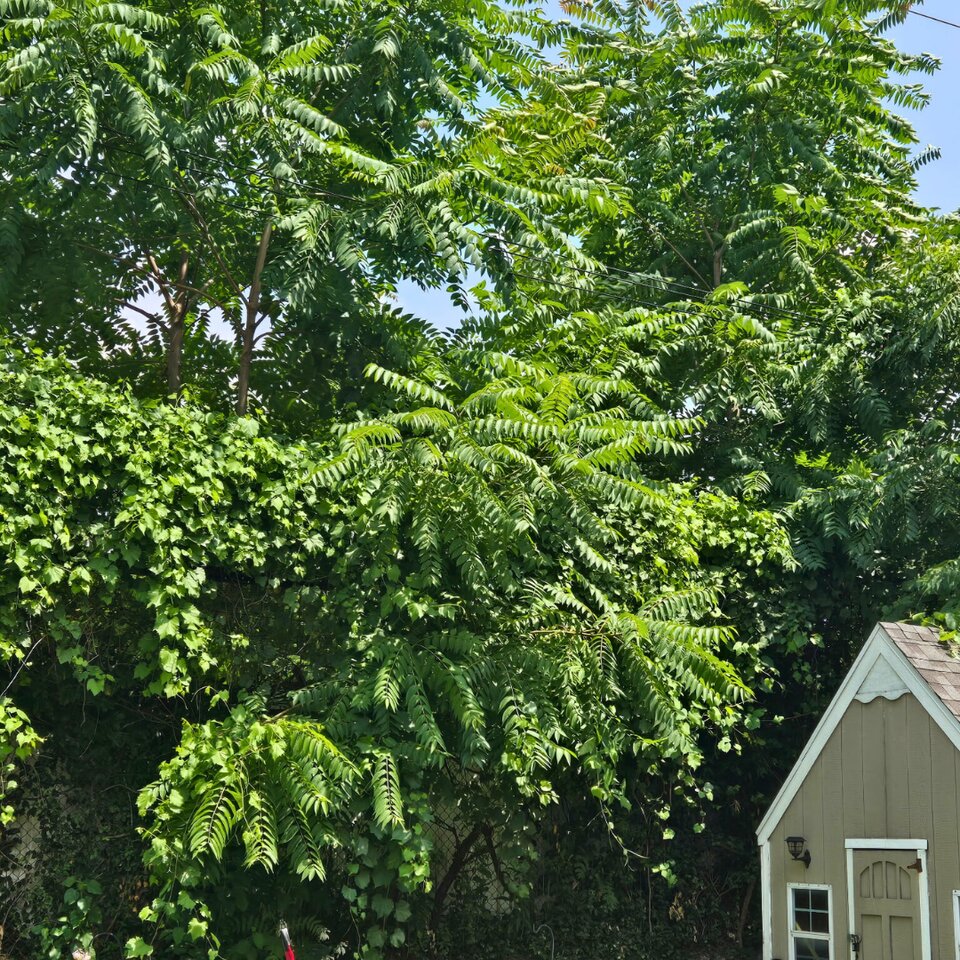July 30 2025
Invasive Species Watch: Tree of Heaven

From the Ferndale Environmental Sustainability Commission: Invasive species watch! Are you familiar with the tree of heaven? Tree of heaven (Ailanthus altissima) is an aggressive and fast-growing invasive plant that’s been spotted throughout Ferndale—especially in backyards, alleyways, and along fence lines. Despite its name, this tree can cause problems for native ecosystems and local infrastructure.
What is it?
Tree of heaven (TOH) is a non-native tree introduced from Asia that thrives in places where native trees often struggle. It grows quickly (saplings can grow 3-4 ft in a single season!), spreads through root suckers and seeds, and can be mistaken for sumac or black walnut. By the time most people notice it, it’s already several feet tall.
You may have seen it growing:
- Along fence lines and alleys
- In gardens and lawns
- From cracks in pavement or building foundations
- Within close proximity to homes and other structures
Why is it important?
-
Damages sewer lines and building foundations with its aggressive root system.
-
Poses a hazard to power lines, buildings, and people due to weak wood that breaks easily in storms.
-
Crowds out native plants by releasing chemicals into the soil that suppress other species.
-
Hosts the Spotted Lanternfly, an invasive insect now threatening Michigan agriculture and forests.
-
Spreads & grows rapidly, forming dense colonies that are very difficult to control.
-
Produces high pollen levels, worsening seasonal allergies.
-
Can cause health issues, including skin rashes and, in rare cases, heart inflammation (myocarditis), from contact with sap.
How do I get rid of it?
Cutting tree of heaven will not kill it—this encourages even more growth. One effective method is to treat it with herbicide first, then remove the tree once it starts to die.
What to Do:
-
Apply a systemic herbicide containing Triclopyr or Glyphosate between mid-July and early October—when the tree is actively transporting nutrients to the roots.
-
Use targeted application methods:
-
Hack-and-squirt: Make small cuts around the trunk and squirt herbicide directly into the cuts.
-
Basal bark treatment: Apply herbicide to the lower trunk (best for smaller trees).
-
-
Wait about 30 days for leaves to fall and signs of dieback.
-
Then cut down the tree and monitor the area for regrowth.
According to Penn State Extension, these herbicides pose little risk to other plants when used correctly and do not persist in soil. Always wear protective gloves and clothing when handling herbicides.
If you're a renter, speak with your landlord about removing the tree. The longer tree of heaven is left to grow, the harder it becomes to manage.
What to Wear:
If you plan to handle tree of heaven or apply herbicide, wear protective clothing to stay safe:
-
Gloves (preferably chemical-resistant or nitrile)
-
Long sleeves and long pants to avoid skin contact with sap
-
Closed-toe shoes or boots
-
Eye protection if you’re using herbicide or working near branches
-
Mask or respirator (optional but helpful if you're sensitive to pollen or working with herbicides)
What can I plant instead?
Choose Michigan native trees that benefit pollinators, wildlife, and soil health. Great alternatives to tree of heaven include:
-
Eastern redbud
-
Serviceberry
-
Red oak
-
Hackberry
-
White pine
Organizations like ReLeaf Michigan offer planting resources and native tree recommendations.
Learn More: Videos and Resources
Watch this short 6-minute webinar from Penn State for an excellent overview of identification and control strategies.
More Resources:
Please reach out to Zero Waste Manager for questions or concerns at zerowaste@ferndalemi.gov.




